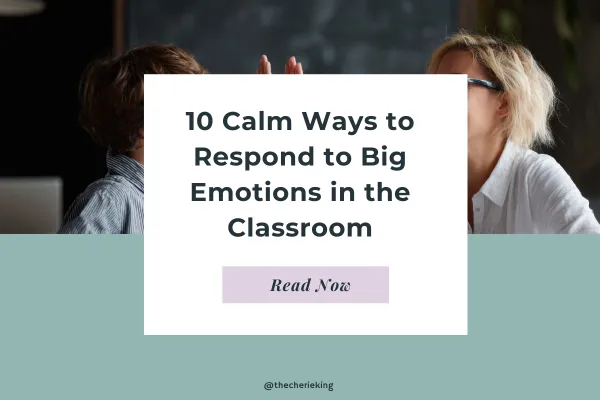
10 Calm Ways to Respond to Big Emotions in the Classroom?
10 Calm Ways to Respond to Big Emotions in the Classroom
Big behaviours are usually little nervous systems asking for help. Instead of seeing “misbehaviour,” let’s read the message underneath: I’m tired. I’m overwhelmed. I don’t feel safe. I need connection. When we respond with calm, clarity, and care, we protect learning and relationships.

Below are ten step-by-step responses you can lean on. Adapt them to your context and the children you serve.
1. Regulate You First (Co-regulation before correction)
Why: Children borrow your calm before they find their own.
How to:
Soften your shoulders, lower your voice, slow your breathing.
Ground: “Feet on the floor, breathe in 4, out 6.”
Script: “You’re safe. I’m here. We’ll work this out together.”
2. Safety & Space Check
Why: Dysregulated brains can’t access logic.
How to:
Move closer but sideways (non-threatening stance).
Reduce stimulation (lower lights/volume, fewer eyes on the child).
Offer choices of proximity: “Sit beside me or on the calm cushion?”
3) Name & Validate the Feeling
Why: Naming emotions lowers intensity and builds emotional literacy.
How to:
Reflect: “Looks like you’re frustrated that the block broke.”
Normalize: “Big feelings happen. We can handle them together.”
Avoid dismissals (“You’re fine”); use acceptance + boundary (see #4).
4. Hold a Clear, Kind Boundary
Why: Safety = warm limits + predictable follow-through.
How to (A.C.T. frame):
Acknowledge: “You wanted the truck.”
Clarify: “Hitting hurts.”
Target alternative: “Hands are for safe play. Let’s try asking for a turn.”
Short scripts beat lectures.
5) Offer a Regulation Strategy (choose one)
Why: Kids need a replacement behaviour that regulates the body.
How to:
Breath: Flower/Candle (smell the flower, blow the candle).
Press: Wall push-ups, chair push-downs, playdough squeeze.
Move: Slow animal walks (turtle, sloth), 10-second shake-and-freeze.
Co-regulate: “Breathe with me… in 2-3-4, out 2-3-4-5-6.”
6. Use Brief Restorative Problem-Solving (after calm)
Why: Teach skills, don’t shame.
How to (3 minutes):
What happened? (child’s story)
Who was affected? (empathy prompt)
How can we make it right? (repair plan: check-in, fix/clean, draw a sorry note, practice asking for a turn)
Script: “Next time, what could you try first - asking for help or using the timer?”
7. Adjust the Environment (preventative design)
Why: Many behaviours are environment-triggered.
How to:
Visual timetable at eye level; preview transitions (“Two minutes, then pack-away”).
Reduce visual/auditory clutter; create a calm corner with soft textures and breathing visuals.
Offer structured choices to increase agency: “Paint or puzzles?”
8. Teach the Missing Skill Explicitly
Why: Behaviour is often a skills gap.
How to:
Mini-lessons on: turn-taking, asking for space, waiting, “stop”/“go slow” language.
Model with puppets/role-play; practice during calm times.
Reinforce process: “You waited and used your words, great self-control.”
9. Track Patterns & Partner with Families
Why: Data + partnership = better support.
How to:
Jot quick notes: trigger, time, setting, what helped.
Share strengths and specifics with families: “Mornings after outdoor play are hardest; movement first is helping.”
Co-create one simple plan at school + home (same words, same cues).
10. Protect Your Wellbeing (because it protects theirs)
Why: Teacher wellbeing = classroom wellbeing.
How to:
Micro-pauses: three slow breaths between activities.
Buddy system: tag-in with a colleague for 2-minute resets.
Compassionate reflection: “What went well? What will I try tomorrow?”
Remember: You are the strategy that makes all other strategies work.
Quick Scripts You Can Steal
“I won’t let you hit. Hands are for safe touch. Let’s stomp it out together.”
“You’re mad and you wanted it now. Breathe with me—then we’ll use the timer.”
“We had a hard moment. Our relationship is okay. Let’s repair and try again.”
Final Word
Responding to misbehaviour isn’t about control; it’s about connection + skills + safety. When we co-regulate first, teach the missing skill, and design calmer environments, we turn hard moments into learning that lasts.
Want plug-and-play tools for calmer days?
Download my FREE Calm Classroom Toolkit and discover easy, mindful activities that support teacher wellbeing, children’s emotional growth, and daily connection.
Your calm is the catalyst. Your classroom is the change.
Connect with me:
Facebook: https://www.facebook.com/thecherieking
Instagram: https://www.instagram.com/thecherieking/